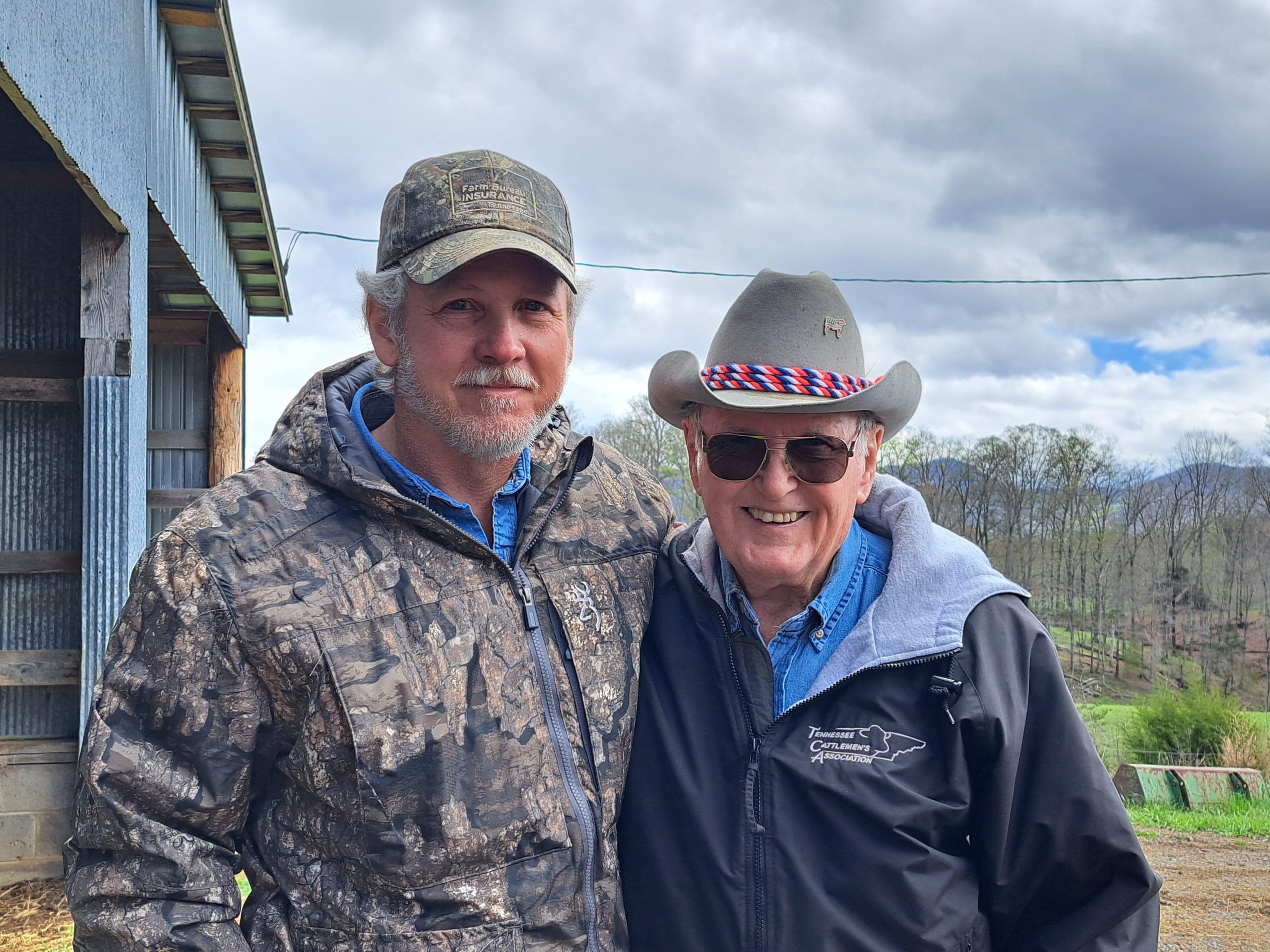
There were no sunglasses in evidence Wednesday morning, April 3rd, 2024, when a group of students from the Culinary Arts Division of Walters State Community College met and traveled to a local beef producer’s farm just outside of Sevierville, Tennessee. The spring day was overcast, blustery, and thirty degrees cooler than it had been the two previous days. The old timers would label it “airish” but to the rest of us, it was strictly cold. But a cold day out in the field is still better than a warm day behind a desk, and we were all thankful it wasn’t raining.
The landowner, Lynn McMahan, had taken the day off from trucking to host the group of students, together with organizer Mike Sharp, TN Beef Industry Council & Cattlemen’s Association; Dr. Katie Mason, a professor with the University of Tennessee; Mallory Fancher, a recent graduate student of ruminant nutrition; Sevier County Ag Extension director Adam Hopkins; and Amy Johnson, secretary for Sevier County Soil & Water Conservation District and Natural Resource Conservation Service (USDA-NRCS).
Students were here to see firsthand where the beef they prepare comes from, starting with the calves born on site in October. We drove up the graveled lane to the large barn. We gathered inside, hunkered in clothes that proved inadequate against the wind that howled around the corners. From the front of the barn, the mountain was clearly visible and beginning to fill with vibrant greens as new growth climbed up the ridge.
Lynn, who sits on both the Sevier County Farm Bureau and Soil & Water Conservation boards, Master Beef Producer, and member of the Cattlemen’s Association, runs anywhere from 40-60 momma cows on his property, which he rotationally grazes for optimum forage. It started as a method to reduce parasites, but as time went on, other perks surfaced. The property graciously described as “rolling” farmland would be described as “pretty steep” by anyone who traversed it on foot. But the cows don’t mind. They happily cropped the tender spring grass and quietly moved below us as we talked about farming in this day and age.
Lynn is a thoughtful, methodical, soft-spoken man who depends on his vet of over twenty years for vaccine protocols. He is not one to chase down the latest technology or trends advertised on RFD, relying instead on proven vaccines and dewormer. What works for him as a part-time farmer may not be the ideal program for cattlemen everywhere. He is focused on gentle cows, Hereford Angus cross, who provide a calf every year. He keeps select heifer calves for replacement stock and buys some along as needed. His bulls are kept on site, vet checked in November, turned in with the ladies January 1st, and pulled after heifer checks in early April. Calving season is October-November, weaning takes place the following June, and shipped to market about 45 days later. During this time, the entire herd are inoculated for respiratory diseases, blackleg, pinkeye, tetanus, treated with an injectable dewormer, and provided with fly tags. Bull calves are banded and navels dipped within 24 hours of hitting the ground. Fly mineral with IGR is provided free choice year round. The action never stops at the farm, and there’s always something needing repaired or built between fencing and equipment, and a field needing sprayed, fertilized, limed, or seeded.
Adam and Mike fielded some questions about antibiotic free meat, and how it is a bit of a marketing gimmick, because all meat labeled for human consumption must be free of antibiotics, hence the “withdrawal period” stated on the label. Producers are no longer able to buy over the counter antibiotics, they must all come via a veterinarian prescription, and vets are not licensed to distribute without having a clear working relationship with the requestor. Industry professionals are anticipating vaccines to be prescription only before much longer. It is imperative to always read the label on whatever product you are using, as loading and withdrawal varies by vaccine and brand. The new cases of Avian Flu found in Texas were addressed, and how many diseases are carried through natural water sources and bird droppings. This is why educated producers are focused on transitioning to automatic waterers for all livestock. Two were in sight from our vantage point on top of the hill.
Dr. Mason led us into a discussion about preferred breeds of cattle for industry needs, and the characteristics of specific beef breeds. She referred us to her handout as we walked through the life cycle of a beef cow. It takes two to three years to bring beef from farm to fork. Students learned that calves weigh between 60-100 pounds at birth, weaned at the producer’s discretion between 6-12 months old, finished on either grass or at a feedlot (typically out west) on mainly grain and plant by-products with some roughage. They will weigh 1200-1400 pounds on the hoof at market. Once slaughtered, you are looking at only half that weight as packaged meat. They found this information staggering. Mike spoke up and showed examples of byproducts that are incorporated into feed, which included corn syrup, corn starch, oils, flours, rolled oats, and even jellybeans.
Students were curious about how the selling was handled. Once you have shipped your cattle to market, you aren’t at liberty to dicker and demand a higher price. You are paid whatever the bidder agrees to per pound. That is the end of the farmer’s share, no matter what the finished product brings. It is difficult to equate a quality steer with excellent lineage for marbling bringing $1.40 a pound live weight, and his Porterhouse steak costing upwards of $50.00 in a restaurant. It was a humbling moment looking at it from a farmer’s standpoint. You factor in the cost of equipment: tractors, rotary cutters, hay baling equipment, not to mention land taxes and of course, fertilizer, the lifestyle is overwhelming, and sometimes downright discouraging. Farmers fight all the same things the rest of us do, but they are also fighting or working with the weather. So when a developer comes along with an offer to buy the land for more than you could ever hope to profit in twenty years, and there’s no one in your family seeming eager to take the reins, it’s hard to turn down a life with a little cushion around the edges.
One of the students asked what incentives were offered to keep farmers in business. Amy stepped in to talk about the grants available through NRCS and Tennessee Department of Agriculture on a cost share basis. These programs are in place, along with TAEP, to provide monetary assistance to fence out ponds, creeks, and rivers and put in automatic waterers, build hay and equipment sheds, provide access roads, and many other conservation practices. When the producer has some equity in the project, in addition to financial assistance from a government agency, they are more likely to stay the course. A willingness to farm boils down to passion and loving what you do. Love for your craft cannot be bought. Those of us who have stood with a producer on their place, their Heaven on Earth, know the truth of this as they look you in the eye and tell you their purpose. Their farm is their pride, it is their joy, and sometimes, it is their heartache.
We moved outside to observe the herd a little closer and our discussion turned towards nutrition and digestion, with Mallory explaining the sophisticated bovine stomach. We’ve all observed cattle grazing, but they require more than the sparse grass in winter, and that’s where hay and protein supplements come in.
It is often impossible in education to know if you’re making a difference. Your students move on, and more likely than not, you never hear from them again. If you have an alumni association at the college level, you can maybe track their success. But the children we try to reach, the young ones watching what goes into growing our food, and then into our bodies, it’s hard to tell what sticks past recess, let alone into adulthood.
Just before the class dispersed, Lynn motioned us into a circle. He spoke of a day at school where his 4th grade class filed into the auditorium and a man talked to them about a program called 4-H. He gave details about what the club entailed, from raising chickens or a hog or a feeder steer. Students were encouraged to come pick up a flyer from the front of the room once the presentation ended if they thought they might be interested. But our host was so painfully shy at that age, he couldn’t make himself go talk to the man and get a brochure. He was in the group walking out when the man approached him. Little Lynn didn’t know this man, but this gentleman knew him, and knew his dad, and knew his grandad. “Here, son, take one of these. I think you’d enjoy it.”
And that man was Mike Sharp, the organizer of so many events in our county and beyond. The man who has never tired of spreading the word about quality beef. The man who does it because he loves it, and who was standing with us today, in the barn of a man who has built a life around conservation agriculture…because it started with a pamphlet about 4-H.



Related Posts
This Farmer I Knew
I hope that my words never seem disrespectful. I usually feel the need to purge…
05 April 2024Combined Love
I got a little emotional the other day. Sometimes you have those moments where you…
05 April 2024

Leave A Comment